Logistics Design for Mobile Battery Energy Storage Systems
Abstract
1. Introduction
Related Works
2. Methodology
3. Results
4. Conclusions
Author Contributions
Funding
Conflicts of Interest
Nomenclature and Parameter Values
| NEV | The total number of EVs = 10,000 EVs |
| NEVCS | The total number of EVCSs = 27 EVCSs |
| NBESS | The total number of mobile BESS units |
| NEST | The total number of ESTs |
| The battery’s capacity of the ith EV | |
| The battery’s SoC of the ith EV | |
| The minimum SoC of an EV to require charging = 20% | |
| The number of EV arrivals at an EVCS | |
| A counter for EVs that satisfy the charging requirements and it resets to zero at each EVCS | |
| A counter for scanned EVs among NEV and it resets to zero at each hour | |
| The parking time duration of the ith EV | |
| The power rating of the slow charging facility | |
| The power rating of the medium charging facility | |
| The power rating of the fast charging facility | |
| The power rating of the charging facility chosen by the ith EV | |
| CI | The annualized investment costs of the logistics system |
| CO&M | The annualized operations and maintenance costs of the logistics system |
| CEST | The total costs of the ESTs |
| μ | The cost of each EST = $150 K |
| CBESS | The total costs of the mobile BESS units |
| δ | The cost of each mobile BESS unit = $100 K |
| α, β | Two economical annuity factors |
| The economical discount rate or the cost of capital = 5% | |
| The economic life of ESTs = 25 years | |
| The economic life of mobile BESS units = 25 years | |
| The cost of energy per mile = $0.165/mile | |
| Dtot | The annual total distance driven by ESTs to deliver mobile BESS units |
| The annual maintenance cost of ESTs = 5% of | |
| The annual maintenance cost of mobile BESS units = 5% of | |
| The average annual salary of an EST operator = $70 K | |
| The distance between the BESS plant and the ith EVCS | |
| The number of shipments or trips that the ith EVCS requires annually |
References
- Energy Information Administration (EIA). Annual Energy Outlook 2019 with Projections to 2050 (AEO 2019); Energy Information Administration (EIA): Washington, DC, USA, 2019; p. 83. Available online: https://www.eia.gov/outlooks/aeo/pdf/AEO2019.pdf (accessed on 21 December 2019).
- Li, C.; Negnevitsky, M.; Wang, X.; Yue, W.L.; Zou, X. Multi-criteria analysis of policies for implementing clean energy vehicles in China. Energy Policy 2019, 129, 826–840. [Google Scholar] [CrossRef]
- Qiao, Q.; Zhao, F.; Liu, Z.; He, X.; Hao, H. Life cycle greenhouse gas emissions of Electric Vehicles in China: Combining the vehicle cycle and fuel cycle. Energy 2019, 177, 222–233. [Google Scholar] [CrossRef]
- Li, W.; Long, R.; Chen, H. Consumers’ evaluation of national new energy vehicle policy in China: An analysis based on a four paradigm model. Energy Policy 2016, 99, 33–41. [Google Scholar] [CrossRef]
- Hayajneh, H.S.; Zhang, X. Evaluation of Electric Vehicle Charging Station Network Planning via a Co-Evolution Approach. Energies 2020, 13, 25. [Google Scholar] [CrossRef]
- Hou, K.; Xu, X.; Jia, H.; Yu, X.; Jiang, T.; Zhang, K.; Shu, B. A Reliability Assessment Approach for Integrated Transportation and Electrical Power Systems Incorporating Electric Vehicles. IEEE Trans. Smart Grid 2018, 9, 88–100. [Google Scholar] [CrossRef]
- Hayajneh, H.S.; Bashetty, S.; Salim, M.N.B.; Zhang, X. Techno-Economic Analysis of a Battery Energy Storage System with Combined Stationary and Mobile Applications. In Proceedings of the 2018 IEEE Conference on Technologies for Sustainability (SusTech), Long Beach, CA, USA, 11–13 November 2018; pp. 1–6. [Google Scholar]
- Barth, M.; Jugert, P.; Fritsche, I. Still underdetected—Social norms and collective efficacy predict the acceptance of electric vehicles in Germany. Transp. Res. Part F Traffic Psychol. Behav. 2016, 37, 64–77. [Google Scholar] [CrossRef]
- Hayajneh, H.S.; Bani Salim, M.N.; Bashetty, S.; Zhang, X. Optimal Planning of Battery-Powered Electric Vehicle Charging Station Networks. In Proceedings of the 2019 IEEE Green Technologies Conference (GreenTech), Lafayette, LA, USA, 3–6 April 2019; pp. 1–4. [Google Scholar]
- Hayajneh, H.; Salim, M.B.; Bashetty, S.; Zhang, X. Logistics system planning for battery-powered electric vehicle charging station networks. J. Phys. Conf. Ser. 2019, 1311, 012025. [Google Scholar] [CrossRef]
- Hayajneh, H.S.; Lainfiesta, M.; Zhang, X. Three Birds One Stone: A Solution to Maximize Renewable Generation, Incentivize Battery Deployment, and Promote Green Transportation. In Proceedings of the 2020 IEEE Innovative Smart Grid Technologies Conference North America (ISGT NA 2020), Washington, DC, USA, 17–20 February 2020. [Google Scholar]
- Hayajneh, H.S.; Lainfiesta, M.; Zhang, X. A New Form of Battery Energy Storage Systems for Renewable Energy Farms. In Proceedings of the 2020 IEEE PES T & D Conference, Chicago, IL, USA, 20–25 April 2020. [Google Scholar]
- Fagerholt, K.; Christiansen, M. A combined ship scheduling and allocation problem. J. Oper. Res. Soc. 2000, 51, 834–842. [Google Scholar] [CrossRef]
- de Oliveira, L.K.; dos Santos, O.R.; de Oliveira, R.L.M.; Nóbrega, R.A.A. Is the Location of Warehouses Changing in the Belo Horizonte Metropolitan Area (Brazil)? A Logistics Sprawl Analysis in a Latin American Context. Urban Sci. 2018, 2, 43. [Google Scholar] [CrossRef]
- Lu, E.H.-C.; Yang, Y.-W. A hybrid route planning approach for logistics with pickup and delivery. Expert Syst. Appl. 2019, 118, 482–492. [Google Scholar] [CrossRef]
- Powell, W.B. An operational planning model for the dynamic vehicle allocation problem with uncertain demands. Transp. Res. Part B Methodol. 1987, 21, 217–232. [Google Scholar] [CrossRef][Green Version]
- Vasilakos, S.; Iacobellis, G.; Stylios, C.D.; Fanti, M.P. Decision Support Systems based on a UML description approach. In Proceedings of the 2012 6th IEEE International Conference Intelligent Systems, Sofia, Bulgaria, 6–8 September 2012; pp. 041–046. [Google Scholar]
- Fanti, M.P.; Iacobellis, G.; Nolich, M.; Rusich, A.; Ukovich, W. A Decision Support System for Cooperative Logistics. IEEE Trans. Autom. Sci. Eng. 2017, 14, 732–744. [Google Scholar] [CrossRef]
- Giusti, R.; Manerba, D.; Perboli, G.; Tadei, R.; Yuan, S. A New Open-source System for Strategic Freight Logistics Planning: the SYNCHRO-NET Optimization Tools. Transp. Res. Procedia 2018, 30, 245–254. [Google Scholar] [CrossRef]
- Rześny-Cieplińska, J.; Szmelter-Jarosz, A. Assessment of the Crowd Logistics Solutions—The Stakeholders’ Analysis Approach. Sustainability 2019, 11, 5361. [Google Scholar] [CrossRef]
- Xu, J.; Hancock, K.L. Enterprise-wide freight simulation in an integrated logistics and transportation system. In Proceedings of the 2003 IEEE International Conference on Intelligent Transportation Systems, Shanghai, China, 12–15 October 2003; Volume 1, pp. 534–538. [Google Scholar]
- Holl, A.; Mariotti, I. The Geography of Logistics Firm Location: The Role of Accessibility. Netw. Spat. Econ. 2018, 18, 337–361. [Google Scholar] [CrossRef]
- Kumar, I.; Zhalnin, A.; Kim, A.; Beaulieu, L.J. Transportation and logistics cluster competitive advantages in the U.S. regions: A cross-sectional and spatio-temporal analysis. Res. Transp. Econ. 2017, 61, 25–36. [Google Scholar] [CrossRef]
- Zenzerovic, Z.; Beslic, S. Optimization of cargo transport with a view to cost efficient operation of container ship. In Proceedings of the 25th International Conference on Information Technology Interfaces, 2003. ITI 2003, Cavtat, Croatia, 19 June 2003; pp. 531–536. [Google Scholar]
- Zenzerović, Z.; Bešlić, S. Contribution to the Optimisation of the Cargo Transportation Problem. Promet Traffic Transp. 2003, 15, 65–72. [Google Scholar]
- Kos, S.; Zenzerović, Z. Modelling the Transport Process in Marine Container Technology. Promet Traffic Transp. 2003, 15, 13–17. [Google Scholar]
- Christiansen, M. Decomposition of a Combined Inventory and Time Constrained Ship Routing Problem. Transp. Sci. 1999, 33, 3–16. [Google Scholar] [CrossRef]
- Krile, S. Application of the minimum cost flow problem in container shipping. In Proceedings of the Elmar-2004. 46th International Symposium on Electronics in Marine, Zadar, Croatia, 16–18 June 2004; pp. 466–471. [Google Scholar]
- Kobayashi, K.; Kubo, M. Optimization of oil tanker schedules by decomposition, column generation, and time-space network techniques. Jpn. J. Indust. Appl. Math. 2010, 27, 161–173. [Google Scholar] [CrossRef]
- Kobayashi, H.; Tamaki, H. A method of ship scheduling and inventory management problem for reducing demurrage and freight. In Proceedings of the 2017 IEEE International Conference on Systems, Man, and Cybernetics (SMC), Banff, AB, Canada, 5–8 October 2017; pp. 2790–2795. [Google Scholar]
- He, M.; Shen, J.; Wu, X.; Luo, J. Logistics Space: A Literature Review from the Sustainability Perspective. Sustainability 2018, 10, 2815. [Google Scholar] [CrossRef]
- Direct Store Delivery: Concepts, Applications and Instruments; Otto, A., Schoppengerd, F.J., Shariatmadari, R., Eds.; Springer: Berlin, Germany, 2009; ISBN 978-3-540-77212-5. [Google Scholar]
- Luo, L.; Gu, W.; Zhou, S.; Huang, H.; Gao, S.; Han, J.; Wu, Z.; Dou, X. Optimal planning of electric vehicle charging stations comprising multi-types of charging facilities. Appl. Energy 2018, 226, 1087–1099. [Google Scholar] [CrossRef]
- Zhang, H.; Tang, W.; Hu, Z.; Song, Y.; Xu, Z.; Wang, L. A method for forecasting the spatial and temporal distribution of PEV charging load. In Proceedings of the 2014 IEEE PES General Meeting|Conference Exposition, Washington, DC, USA, 27–31 July 2014; pp. 1–5. [Google Scholar]
- Wang, Y.; Guo, Q.; Sun, H.; Li, Z. An investigation into the impacts of the crucial factors on EVs charging load. In Proceedings of the IEEE PES Innovative Smart Grid Technologies, Tianjin, China, 21–24 May 2012; pp. 1–4. [Google Scholar]
- Tesla Semi: 500-Mile Range, Cheaper Than Diesel, Quick to Charge—ExtremeTech. Available online: https://www.extremetech.com/extreme/259195-tesla-semi-500-mile-range-cheaper-diesel-quick-charge (accessed on 5 March 2019).
- “Comparing Energy Costs Per Mile for Electric and Gasoline-Fueled Vehicles,” Advanced Vehicle Testing Activity, Idaho National Laboratory. Available online: https://avt.inl.gov/sites/default/files/pdf/fsev/costs.pdf (accessed on 28 December 2019).
- Yi, Z.; Shirk, M. Data-driven optimal charging decision making for connected and automated electric vehicles: A personal usage scenario. Transp. Res. Part C Emerg. Technol. 2018, 86, 37–58. [Google Scholar] [CrossRef]
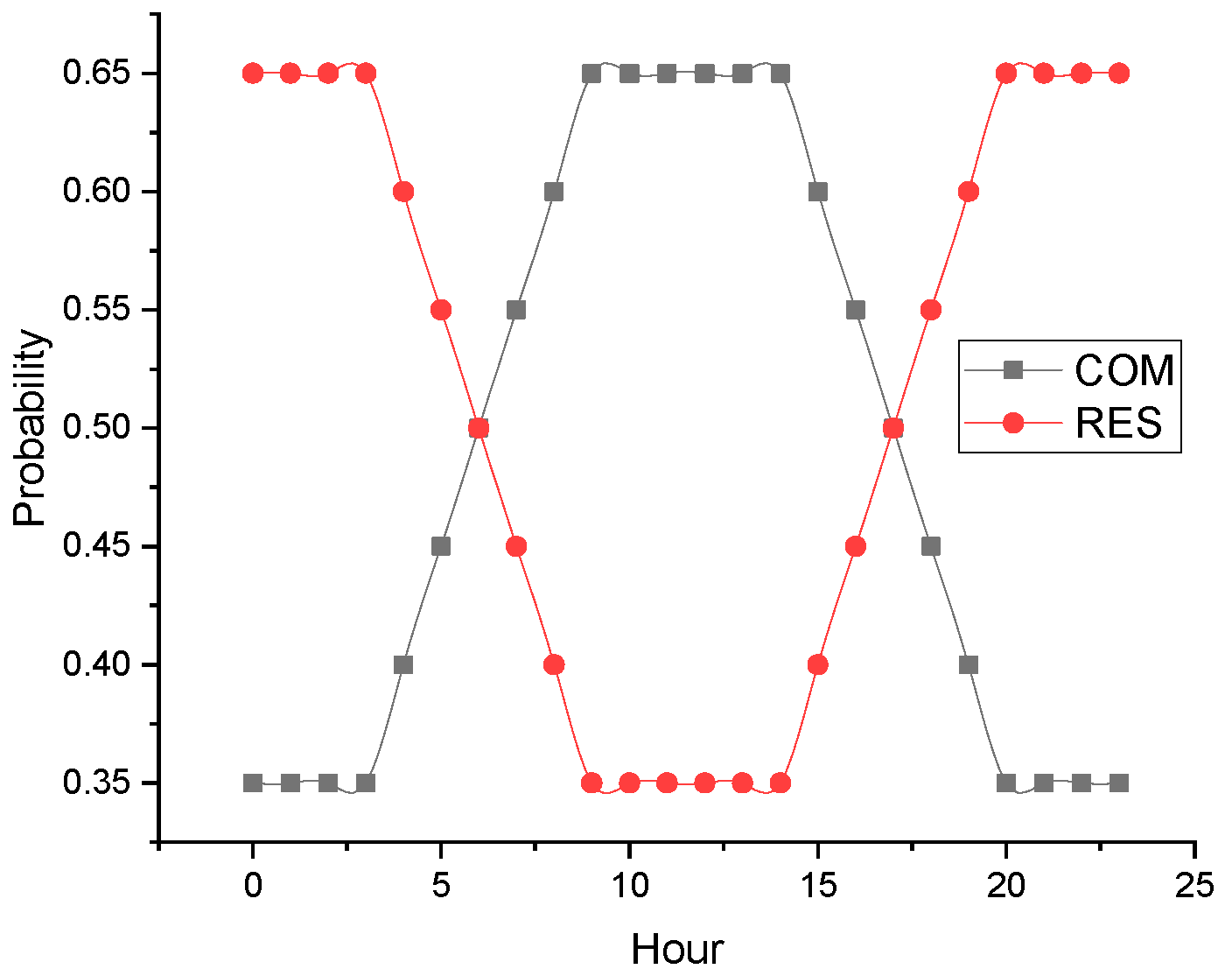
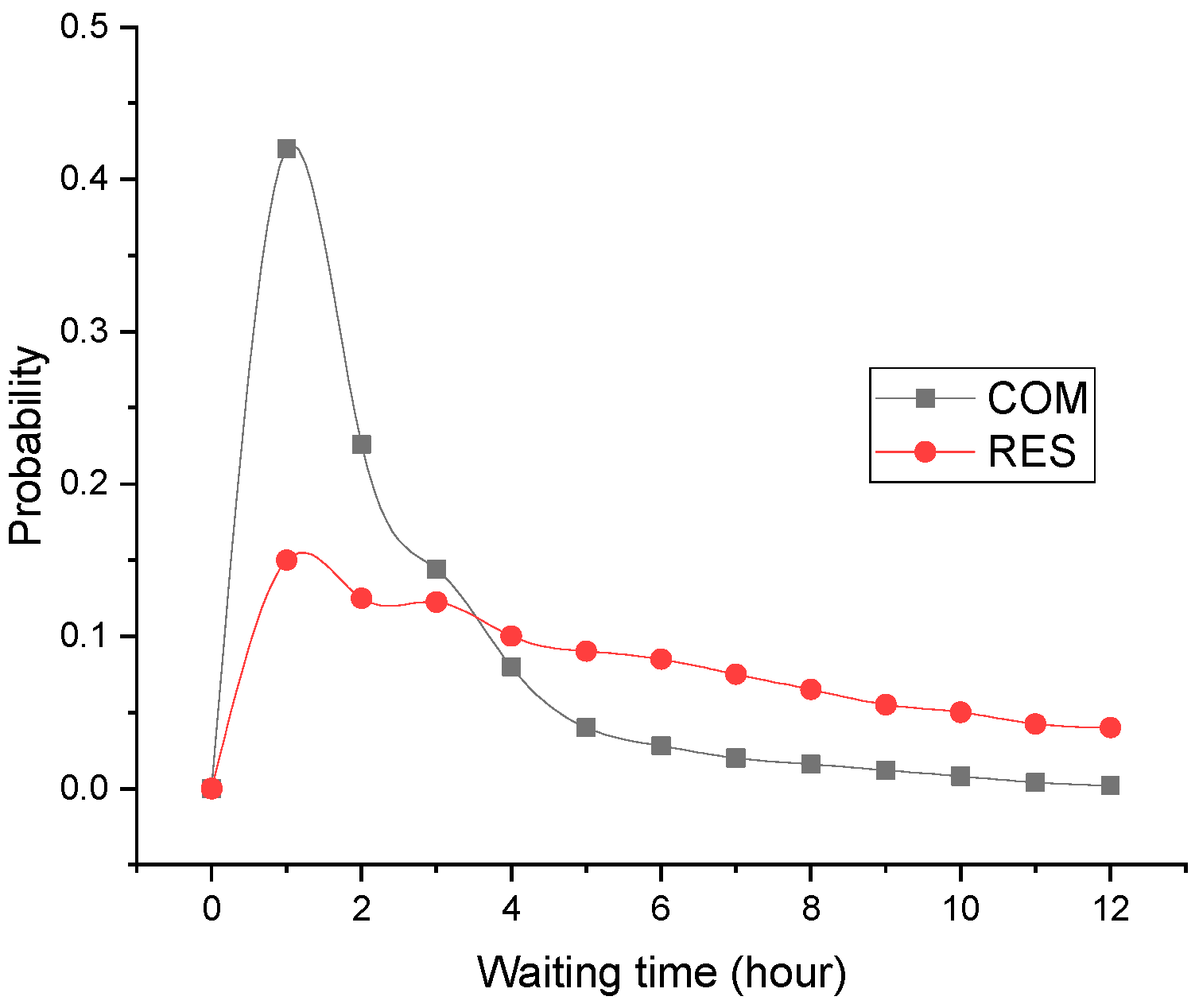
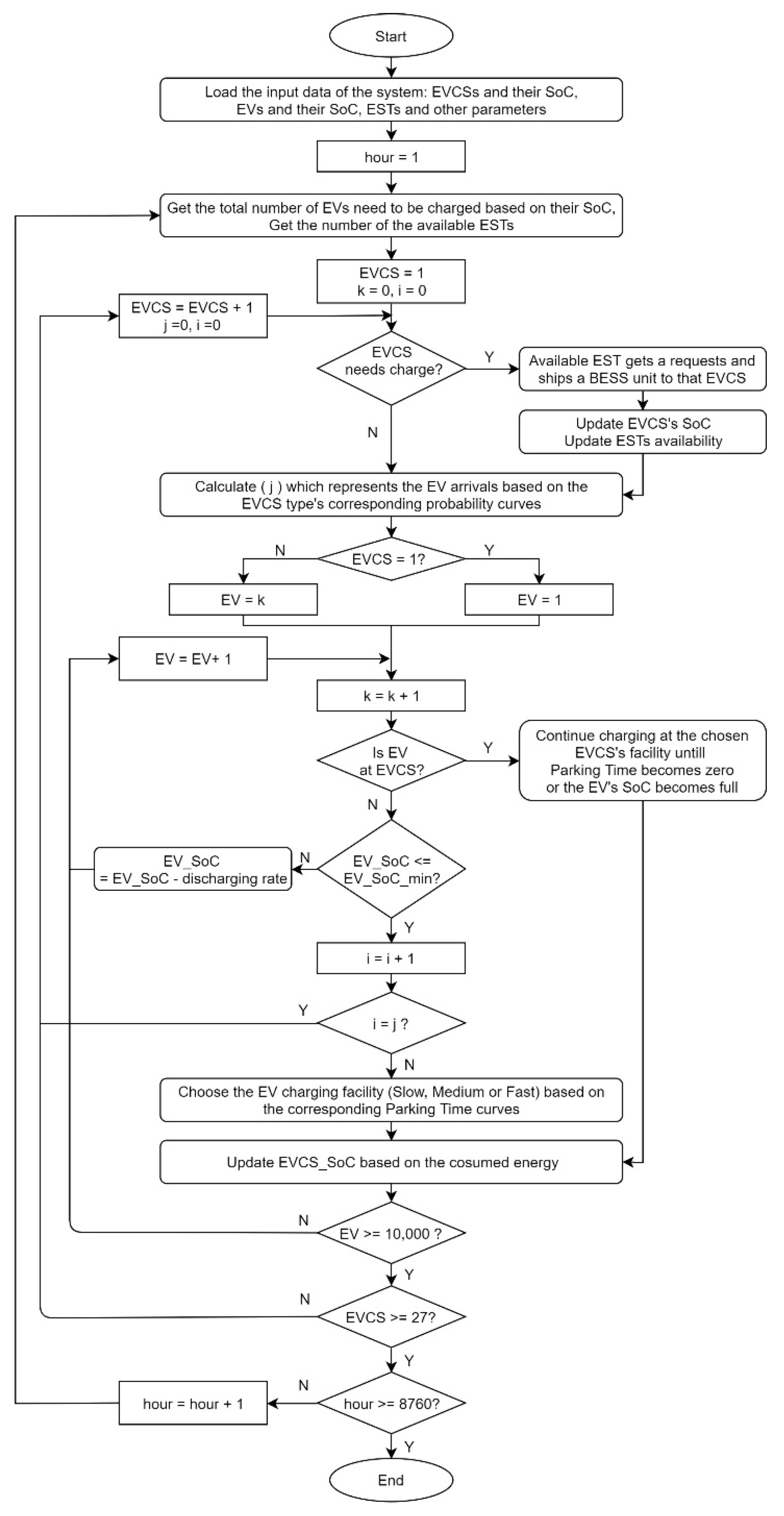
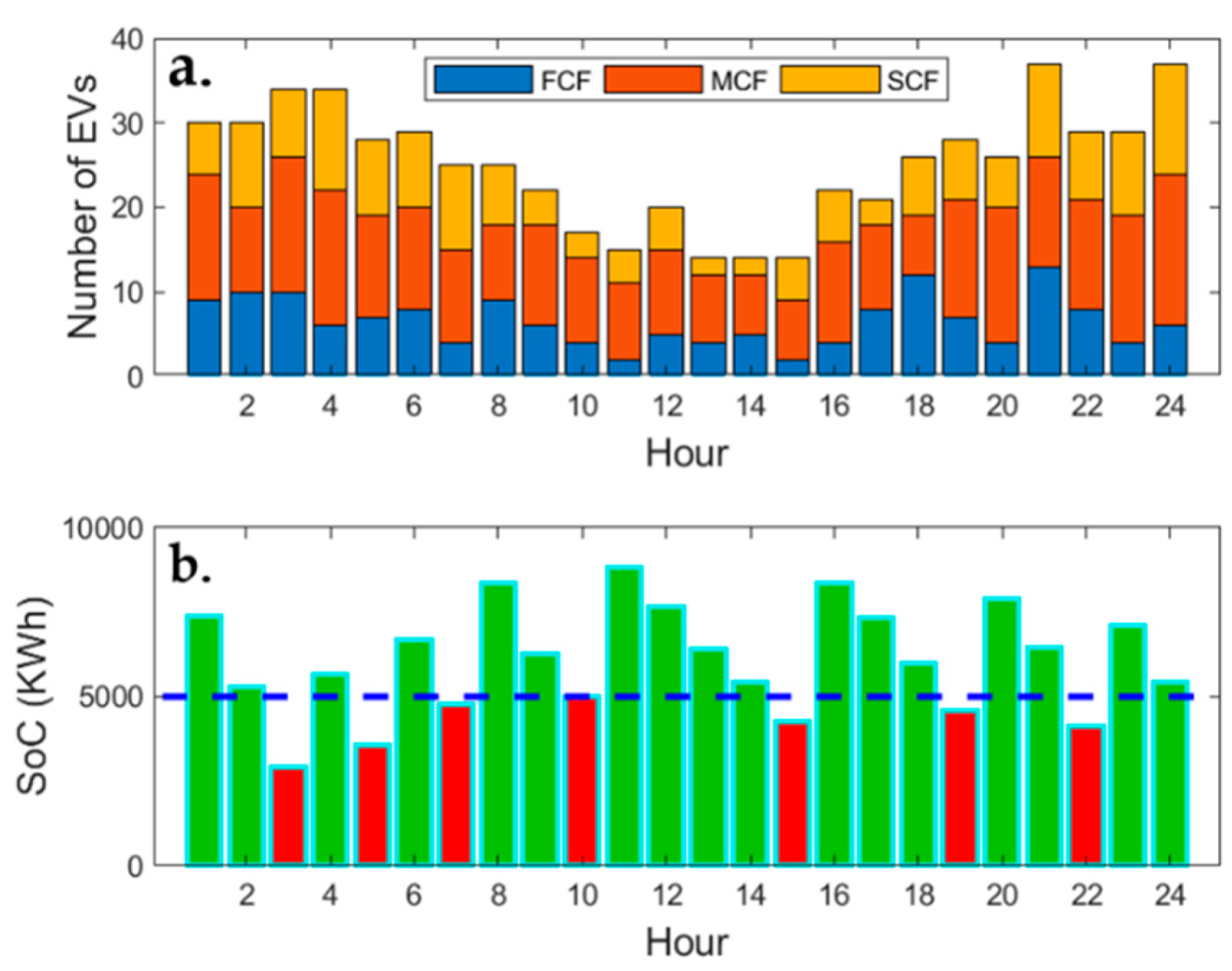

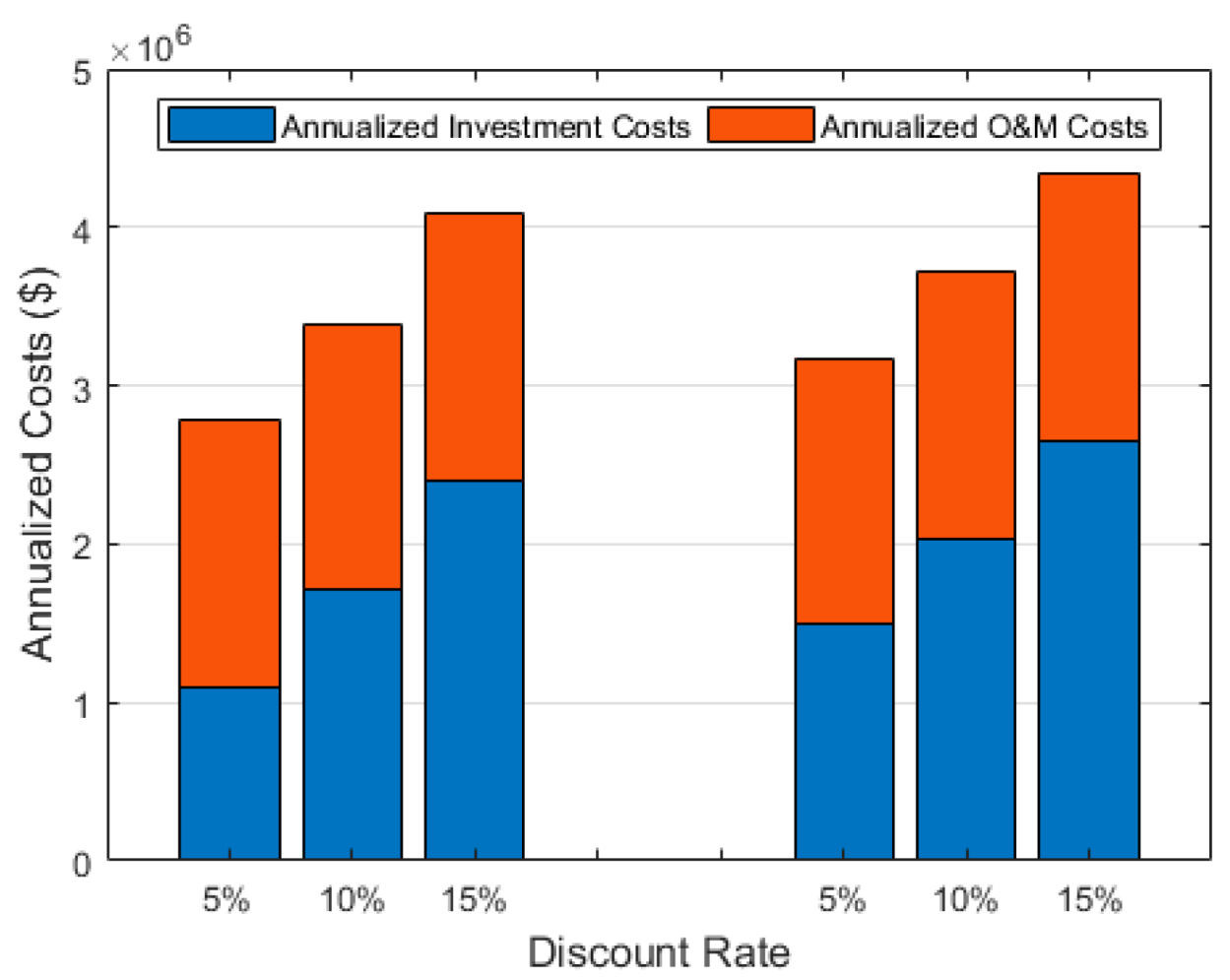

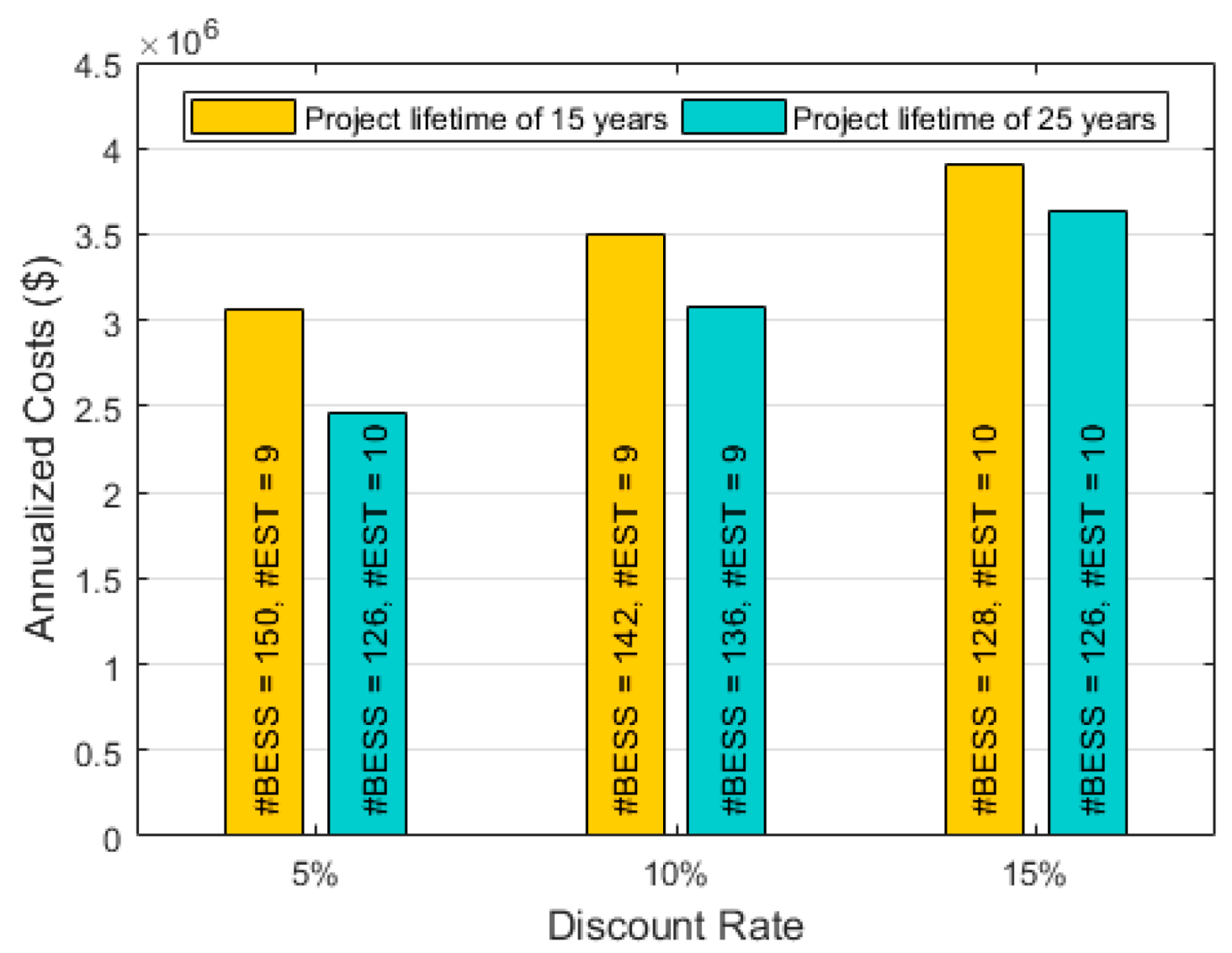
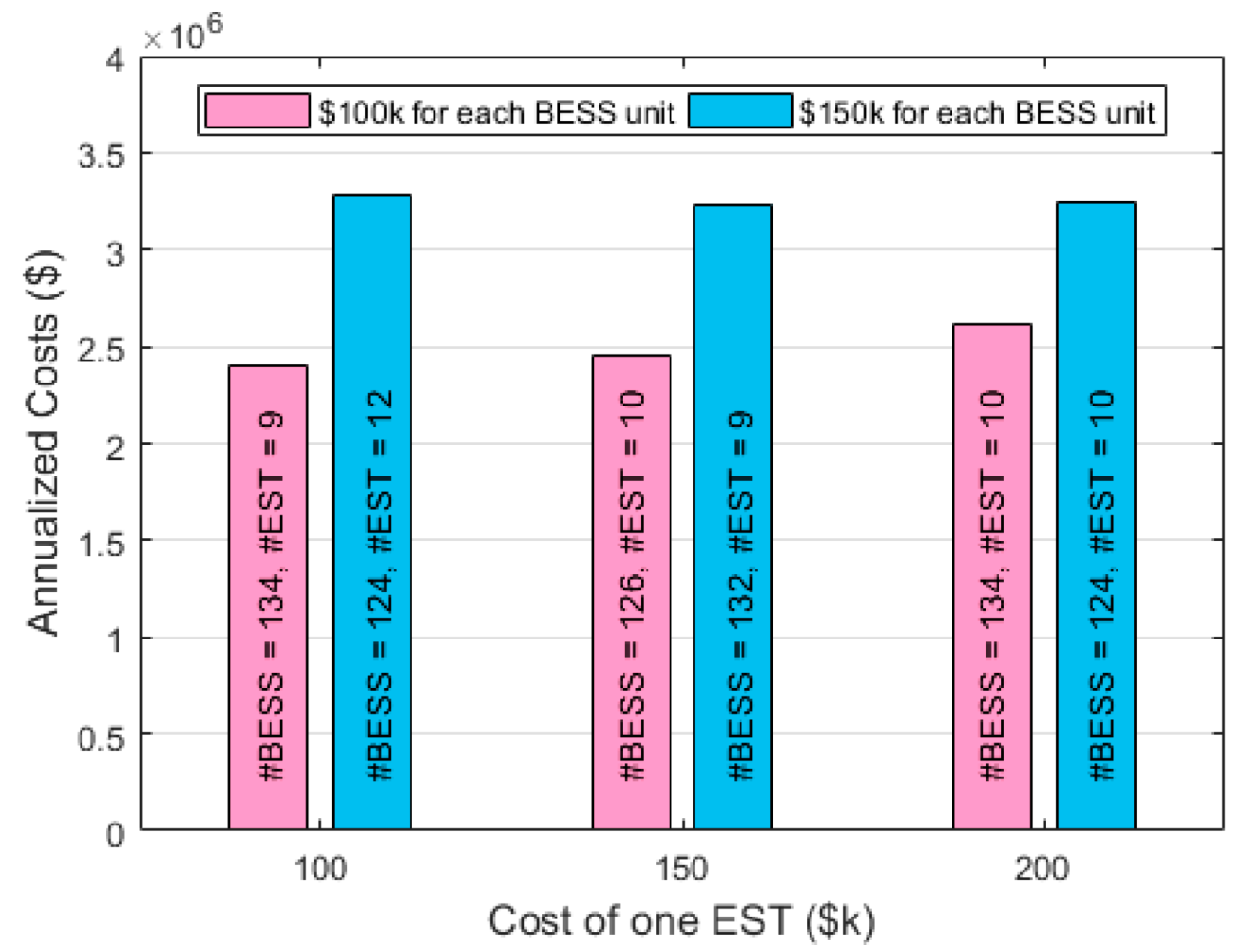
| Discount Rate | Lifetime of ESTs and Mobile BESS Units (years) | Optimum Number of Mobile BESS Units | Optimum Number of EST | Minimum Annualized Cost ($M) |
|---|---|---|---|---|
| 5% | 15 | 150 | 9 | 3.06907 |
| 25 | 126 | 10 | 2.45391 | |
| 10% | 15 | 142 | 9 | 3.49829 |
| 25 | 136 | 9 | 3.07089 | |
| 15% | 15 | 128 | 10 | 3.90900 |
| 25 | 126 | 10 | 3.63470 |
| Cost of One EST ($) | Cost of Mobile BESS Unit ($/Each) | Optimum Number of Mobile BESS Units | Optimum Number of EST | Minimum Annualized Cost ($M) |
|---|---|---|---|---|
| 100 k | 100 k | 134 | 9 | 2.40547 |
| 150 k | 124 | 12 | 3.28334 | |
| 150 k | 100 k | 126 | 10 | 2.45391 |
| 150 k | 132 | 9 | 3.23504 | |
| 200 k | 100 k | 134 | 10 | 2.61062 |
| 150 k | 124 | 10 | 3.23957 |
© 2020 by the authors. Licensee MDPI, Basel, Switzerland. This article is an open access article distributed under the terms and conditions of the Creative Commons Attribution (CC BY) license (http://creativecommons.org/licenses/by/4.0/).
Share and Cite
Hayajneh, H.S.; Zhang, X. Logistics Design for Mobile Battery Energy Storage Systems. Energies 2020, 13, 1157. https://doi.org/10.3390/en13051157
Hayajneh HS, Zhang X. Logistics Design for Mobile Battery Energy Storage Systems. Energies. 2020; 13(5):1157. https://doi.org/10.3390/en13051157
Chicago/Turabian StyleHayajneh, Hassan S., and Xuewei Zhang. 2020. "Logistics Design for Mobile Battery Energy Storage Systems" Energies 13, no. 5: 1157. https://doi.org/10.3390/en13051157
APA StyleHayajneh, H. S., & Zhang, X. (2020). Logistics Design for Mobile Battery Energy Storage Systems. Energies, 13(5), 1157. https://doi.org/10.3390/en13051157






